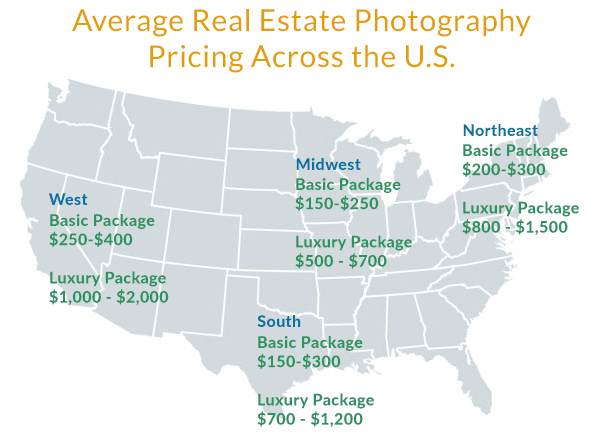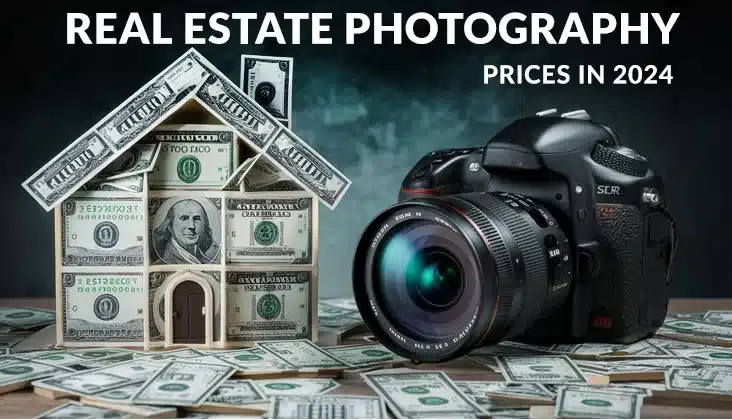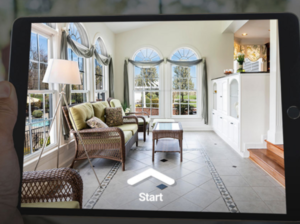Table of Contents
Real Estate Photography Prices in 2024
In the digital era, where the first interaction between potential homebuyers and properties is often through an online listing, the power of high-quality real estate photography cannot be overstated. Exceptional photography does more than present the physical attributes of a property; it captures its essence, portraying it in a manner that resonates emotionally with buyers. This is crucial in a crowded market where a solid first impression can significantly impact a listing’s performance and, ultimately, the sale price.
The significance of real estate photography goes beyond mere aesthetics. Studies and market analyses consistently show that listings with professional photographs sell quicker, and often above market value compared to amateur photography. In this context, understanding the pricing dynamics of real estate photography across different regions of the United States becomes essential for real estate agents and homeowners aiming to maximize their investment in property listings.
This comprehensive article aims to be the ultimate reference for real estate photography pricing in 2024, delving into the factors influencing pricing, regional cost variations, and the additional services that can enhance a property’s appeal to potential buyers.
First, The Evolution of Real Estate Photography
Real estate photography has evolved significantly from simple exterior shots to today’s dynamic visual storytelling that utilizes advanced techniques and technologies. Initially, the focus was on documenting a property’s condition and features. However, as the real estate market moved online, the role of photography transformed. Today, it’s not just about showing a property; it’s about selling a lifestyle.
This evolution was propelled by technological advancements, notably the rise of digital cameras, drones, and virtual tour software. These tools have enabled photographers to capture properties in unprecedented detail and from previously impossible or prohibitively expensive angles.
In a landscape where buyers often scroll through dozens of listings online, the quality of a property’s photographs can be the deciding factor in capturing their interest and motivating them to take the next step.
Why Invest in Professional Real Estate Photography?
Investing in professional real estate photography is no longer a luxury but a necessity for those who want to stand out in a crowded real estate market. Here’s why:
- Enhanced Presentation: Professional photographers have the skills and equipment to capture a property in the best light, highlighting its best features while minimizing less desirable aspects.
- Increased Engagement: Listings with professional photos receive more views and shares on social media, increasing the property’s visibility and the likelihood of a quicker sale.
- Higher Sale Prices: Properties showcased through high-quality photography often command higher asking prices, as potential buyers perceive them as more valuable.
- Faster Sales: A visually appealing listing is more likely to attract serious inquiries, reducing the time the property spends on the market.
Factors Affecting Real Estate Photography Pricing
Several key factors influence the cost of real estate photography:
- Property Size: Larger properties require more time to photograph, impacting the overall cost.
- Location: Photography pricing can vary by region, reflecting the cost of living and service demand.
- Photographer’s Experience and Reputation: Established photographers with a robust portfolio tend to charge more for their expertise and high-quality output.
- Additional Services: Drone photography, virtual tours, and twilight shoots add to the base cost but significantly enhance the listing’s appeal.
Regional Pricing Breakdown in the U.S.
Northeast
In the Northeast, particularly in urban centers like New York City and Boston, real estate photography pricing reflects the premium nature of the properties and the market’s competitiveness. Here, historic and architecturally significant properties abound, necessitating a photography approach that can capture their unique character.
- Basic Packages: Basic photography packages might start around $200-$300 for smaller or less complex properties. These typically include several interior and exterior shots with standard editing.
- Luxury Packages: High-end properties, often featuring unique architectural details or luxury amenities, require more extensive coverage. Luxury packages may range from $800 to $1,500, incorporating advanced techniques like twilight photography, detailed editing, and short promotional videos.
Midwest
The Midwest’s real estate photography market caters to a wide array of properties, from urban dwellings in Chicago to sprawling estates in less densely populated areas. The region’s natural landscapes often play a significant role in the presentation of properties.
- Basic Packages: Starting at $150-$250, basic packages offer comprehensive coverage for standard properties, ensuring high-quality presentation without unnecessary frills.
- High-End Services: Prices can range from $500 to $700 for larger estates or properties with unique features. Services may include drone aerial shots, which are particularly effective in showcasing the expansive landscapes typical in this region.
South
The vibrant markets of the South, including cities like Atlanta, Miami, and Dallas, demand real estate photography that captures the lifestyle and ambiance of the region as much as the properties themselves.
- Entry-Level Packages: Prices for basic photography services in the South start at a similar range to the Midwest, around $150-$300, adjusted for local market conditions.
- Premium Offerings: For high-value properties, especially those on the waterfront or with significant acreage, photography packages can go from $700 to over $1,200. These may include virtual tours, drone photography, and advanced editing to highlight the property’s best features.
West
In the West, especially in tech hubs and luxury resort areas like San Francisco, Los Angeles, and Seattle, real estate photography pricing is on the higher end to match the market’s high-value properties.
- Standard Packages: Due to the competitive nature of these markets, even standard packages are comprehensive, starting from $250-$400. They include high-quality images that cater to both real estate brochures and digital listings.
- Luxury Services: Ranging from $1,000 to $2,000, luxury services cover not just photography but also video tours, drone footage, and virtual staging. The emphasis is on a top-tier presentation to match the exclusivity of the property.

| Service Type | Price Range | Notes |
|---|---|---|
| Standard Listing Photos | $208 - $500 | Average Prices for 10-25 MLS Ready Photos in Major US Cities |
| Twilight Photos | $200 - $300 | 3 to 15+ Images Capturing Properties at Dusk |
| Aerial Drone Photography | $100 - $300 | 5 to 15 Aerial Images |
| Interactive Virtual Tour | $100 - $400 | Based on Home Size, Layout and Tour Details |
| Commercial Real Estate Photography | $200 - $1,500+ | Costs Can Depend on a Variety of Factors |
| Real Estate Photo Editing | $70 - $150 per hour | For Edits Beyond Initial Package Inclusions |
| Community/Area Photos/Attractive Locations | $50 - $100 Additional | For Showcasing Proximity to Amenities or Attractive Locatioins |
An In-Depth Look at Additional Photography Services
Standard Photography Packages
Description and What’s Included: Standard photography packages typically cover the basics for a complete real estate listing. These usually include interior and exterior shots, encompassing all major rooms and key features of the property, like gardens or pools. Standard editing for color correction, lighting adjustments, and minor retouching is also included to ensure the property is presented in the best possible light.
Average Pricing Across Regions: The pricing can vary significantly by region, but prices should range from $150 to $500 as a general guide. Urban areas with high demand and higher living costs often see prices on the upper end of this range, whereas more rural areas might be at the lower end.
Drone Photography
Growing Demand and Advantages for Listings: Drone photography provides a unique perspective of a property, offering aerial views that highlight the scale of the property, the layout of the land, and its context within the neighborhood. It’s particularly advantageous for large estates, properties with unique landscaping features, or homes in visually appealing locations.
Legal Considerations and Cost Implications: The use of drones for commercial purposes, including real estate photography, is regulated by the Federal Aviation Administration (FAA) in the United States. Photographers must have a Remote Pilot Certificate to operate drones legally. These regulations can influence the availability and cost of drone photography services. The additional cost for drone photography can range from $125 to $300 or more, depending on the property’s size and the complexity of the shoot.
Virtual Tours
Types of Tours and Benefits in the Buying Process: Virtual tours can be as simple as a slideshow of images or as complex as a fully interactive 3D property walkthrough. Virtual tours are immersive and allow potential buyers to explore a real estate listing at their own pace from anywhere in the world, making them a powerful tool for engaging distant buyers or those with busy schedules.
Technology Used and Pricing Variability: The technology behind virtual tours has advanced significantly, with platforms now offering 360-degree panoramas and the ability to integrate with VR headsets for an immersive viewing experience. Virtual tours vary based on complexity, ranging from $150 for simple video tours to $600 or more for high-quality 3D tours.
HDR Photography
Explanation and Impact on Real Estate Images: High Dynamic Range (HDR) photography involves taking several photos of the same scene at different exposures and blending them to create a single image with a broader range of colors and lights. This technique ensures that an image’s brightest and darkest parts are detailed and precise, making HDR photography ideal for spaces with significant contrasts, such as brightly lit exteriors and interiors with shadows.
Cost Considerations: HDR photography is often included as part of standard real estate photography packages, but the level of HDR enhancement can vary. Packages emphasizing advanced HDR techniques may be slightly more expensive, reflecting the additional time and expertise required.
Virtual Staging
The Future of Remote Property Viewing and Staging: Virtual staging represents the cutting edge of real estate marketing, allowing potential buyers to explore and envision themselves in a fully furnished property, helping them imagine the potential of a property without needing physical staging.
Note on Pricing and Provider Selection: The cost of virtual staging depends on the provider’s technology and the extent of the virtual staging required. Prices can range from $250 for basic staging to over $1,000 for comprehensive packages. Choosing a provider with a strong portfolio and experience in real estate virtual staging is crucial to ensure high-quality results.
These services play a vital role in modern real estate marketing, offering different benefits to sellers and buyers. Real estate professionals can create compelling listings that stand out in a competitive market by understanding the options available and their associated costs.
Choosing the Right Photographer
Selecting the right photographer for your real estate listing is more than a matter of price—it’s about finding a professional whose style, expertise, and services align with your property’s marketing needs. Here are essential tips for making an informed choice:
Portfolio Evaluation
A real estate photographer’s portfolio shows their unique style and skill level. Look for a range of properties in their portfolio to ensure they have experience capturing the essence of diverse property types. Evaluate their ability to highlight a property’s best features, paying attention to composition, lighting, and the emotions their images evoke. A strong portfolio should showcase the photographer’s technical skills and their ability to tell a property’s story visually.
Service Offerings
As we mentioned, real estate photography encompasses a variety of services beyond basic photography, including drone shots, virtual tours, and HDR images. Determine what services are essential for presenting your property effectively and seek photographers who offer these as part of their packages. Consider their turnaround times, availability to shoot according to your timeline, and any additional services like virtual staging or video tours that could enhance your listing.
Understanding Contract Terms
Before engaging a photographer, thoroughly review their contract terms. Pay close attention to the scope of work, delivery timelines, ownership rights of the photos, usage rights (for both print and digital platforms), and cancellation policies. It’s crucial to clearly understand what’s included in the package, any additional costs that may arise, and the photographer’s policy on revisions or reshoots.
The Role of Photography in Marketing Strategy and Branding
High-quality real estate photography is a cornerstone of effective marketing and branding for real estate professionals. It enhances the attractiveness of listings and reflects on the realtor’s brand, showcasing their commitment to quality and professionalism. The right photographer can help you create a cohesive look for your listings, reinforcing your market positioning and helping to attract your target audience. In a highly visual online marketplace, your visuals’ quality directly influences your properties’ perceived value and can set you apart from competitors.
In essence, choosing the right real estate photographer involves assessing their ability to meet your specific needs through their portfolio, the breadth of their service offerings, and the flexibility of their contract terms. By aligning with a photographer who understands your marketing and branding strategy, you can significantly enhance the presentation and appeal of your listings, contributing to faster sales and higher selling prices.
Future Trends Influencing Pricing and Services
The realm of real estate photography is swiftly changing, spurred by technological advancements and shifting market needs. As we look to the future, several key trends are poised to shape the pricing models and service offerings within the industry.
The Role of Emerging Technologies in Real Estate Photography
- Artificial Intelligence (AI): AI is revolutionizing real estate photography through automated editing software, capable of enhancing photos at a fraction of the time and cost associated with manual editing. AI-driven algorithms can adjust lighting color balance and even compose shots to highlight a property’s best features. As AI technology becomes more sophisticated, it’s expected to offer even more advanced services, such as automatic tagging of features and predictive analytics to determine the photos most appealing to potential buyers.
- Augmented Reality and Virtual Reality: AR and VR technologies are transforming how potential buyers interact with property listings. AR applications allow users to virtually stage homes or overlay property information within photos, providing a richer, more interactive experience. Conversely, VR offers immersive virtual tours, enabling buyers to explore properties remotely in a way that photos alone cannot match. As these technologies become more common, they will likely become standard offerings in real estate photography packages, affecting pricing structures accordingly.
Predictions on How Pricing Models May Evolve
- Subscription and Membership Models: As the demand for continuous content updates grows, especially for high-volume real estate agents or property managers, subscription-based pricing models may become more prevalent. These models could offer ongoing services such as regular updates to listing photos, seasonal photography, and access to emerging technologies like VR tours at a fixed monthly rate.
- Dynamic Pricing Based on Market Demand: With the integration of AI into service platforms, real estate photography providers may adopt dynamic pricing models that adjust based on demand, the complexity of the shoot, and even real-time market trends. This could mean more competitive pricing during off-peak seasons or higher rates for shoots that require the latest technology offerings.
- Bundled Services and Comprehensive Packages: As real estate marketing becomes increasingly digital and multifaceted, photography providers might offer more comprehensive packages that include not just photography but also video production, virtual staging, and digital marketing services. These all-in-one packages would simplify the process for realtors, potentially offering cost savings compared to purchasing services individually.
The upcoming landscape of real estate photography holds thrilling prospects as technology pushes the limits of property marketing and presentation. These progressions will elevate the visual portrayal of listings and introduce fresh avenues to captivate and involve potential buyers. As the sector adjusts to these shifts, pricing structures and service packages will evolve, mirroring the value and intricacy of these inventive solutions.
FAQ Section
Q: What factors influence real estate photography prices in 2024?
A: Prices are influenced by location, property size, photographer experience, and additional services like aerial shots or virtual tours.
Q: Why is professional real estate photography important?
A: Professional photos significantly enhance listing appeal, attracting more potential buyers and often leading to quicker sales at higher prices.
Q: How much should I expect to pay for real estate photography in 2024?
A: Costs vary by region and service package, but investing in quality photography offers a substantial return in the real estate market.
Q: Can I take my own real estate photos?
A: While it’s possible, professional photographers have the equipment, skills, and experience to showcase your property in the best light, making a critical difference in market perception.
Q: Are there any trends in real estate photography I should be aware of?
A: Current trends include the use of drones for aerial photography, virtual staging, and 3D virtual tours, enhancing the online buying experience.





